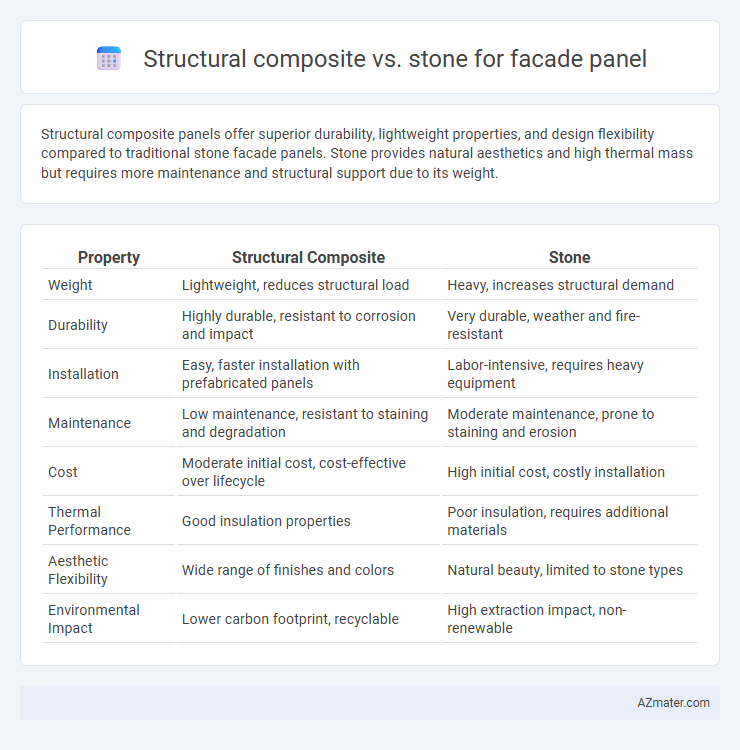Structural composite panels offer superior durability, lightweight properties, and design flexibility compared to traditional stone facade panels. Stone provides natural aesthetics and high thermal mass but requires more maintenance and structural support due to its weight.
Table of Comparison
| Property | Structural Composite | Stone |
|---|---|---|
| Weight | Lightweight, reduces structural load | Heavy, increases structural demand |
| Durability | Highly durable, resistant to corrosion and impact | Very durable, weather and fire-resistant |
| Installation | Easy, faster installation with prefabricated panels | Labor-intensive, requires heavy equipment |
| Maintenance | Low maintenance, resistant to staining and degradation | Moderate maintenance, prone to staining and erosion |
| Cost | Moderate initial cost, cost-effective over lifecycle | High initial cost, costly installation |
| Thermal Performance | Good insulation properties | Poor insulation, requires additional materials |
| Aesthetic Flexibility | Wide range of finishes and colors | Natural beauty, limited to stone types |
| Environmental Impact | Lower carbon footprint, recyclable | High extraction impact, non-renewable |
Introduction to Façade Panel Materials
Structural composite facade panels combine lightweight properties with high strength, offering enhanced durability and design flexibility compared to traditional stone panels. Stone facade panels, such as granite or limestone, provide natural aesthetics and long-lasting weather resistance but tend to be heavier and require robust support systems. Advances in composite materials deliver superior thermal insulation and easier installation, making them increasingly popular for modern architectural applications.
Defining Structural Composites
Structural composites for facade panels combine materials like fiberglass, carbon fiber, or recycled polymers bonded with resins to create lightweight yet highly durable surfaces. These composites offer superior strength-to-weight ratios and enhanced resistance to weathering, compared to traditional stone panels that rely solely on natural stone's inherent hardness and weight. Manufacturing flexibility allows structural composites to be molded into complex shapes, enabling innovative architectural designs with improved thermal and impact performance.
Overview of Natural Stone Façade Panels
Natural stone facade panels offer unmatched durability and aesthetic appeal derived from materials like granite, limestone, and sandstone, providing a timeless, natural look to building exteriors. These panels excel in resistance to weathering, fire, and UV radiation, maintaining structural integrity and color vibrancy over decades with minimal maintenance. Their inherent thermal mass properties improve energy efficiency, while customization options in finishes and textures enhance architectural versatility compared to structural composite panels.
Comparative Durability: Composite vs. Stone
Structural composite panels offer enhanced impact resistance and flexibility compared to natural stone, reducing the likelihood of cracking or chipping under stress. Stone facades exhibit exceptional longevity and natural weather resistance but are more susceptible to erosion and physical damage over time in harsh climates. The composite materials often incorporate UV stabilizers and waterproofing layers, improving durability against environmental factors where stone might require regular sealing and maintenance.
Weight and Structural Load Differences
Structural composite facade panels weigh significantly less than stone panels, typically ranging from 10 to 15 pounds per square foot compared to stone's 50 to 80 pounds per square foot. This substantial weight difference reduces the overall structural load on building frames, allowing for more flexible design options and potentially lower construction costs. Lightweight composites also simplify installation and minimize the need for heavy-duty supporting structures, enhancing seismic performance and easing transportation logistics.
Aesthetic Versatility and Design Options
Structural composite panels offer greater aesthetic versatility for facade applications due to their ability to mimic various textures, colors, and finishes while maintaining lightweight properties. Stone panels provide timeless natural beauty and unique patterns but are limited in customization and heavier in weight. Designers prefer structural composites for innovative, dynamic facades, whereas stone is favored for classic, durable appearances.
Installation Process: Composite vs. Stone
Structural composite facade panels offer a streamlined installation process due to their lightweight nature, allowing for quicker handling, reduced labor costs, and simplified anchoring systems compared to traditional stone panels. Stone facade installation demands heavy machinery, precise lifting equipment, and meticulous alignment to manage the material's weight and fragility, often resulting in longer project timelines. The use of structural composites enhances efficiency on-site by minimizing the need for reinforcement and complex support frameworks typically required for stone panel installations.
Thermal and Acoustic Performance
Structural composite facade panels offer superior thermal insulation with high R-values, significantly reducing heat transfer compared to stone panels, which are inherently heavier and conduct heat more readily. Composite materials often incorporate insulating cores and engineered layers that enhance acoustic dampening, providing better noise reduction than stone, which tends to reflect sound. The lightweight nature of structural composites also allows for improved installation flexibility without compromising thermal or acoustic performance.
Sustainability and Environmental Impact
Structural composite panels offer enhanced sustainability through the use of recycled materials and lower embodied energy compared to stone, which requires intensive quarrying and transportation processes. Composite panels often provide superior thermal insulation, reducing building energy consumption and associated greenhouse gas emissions over their lifecycle. Stone facades, while durable and recyclable, tend to have a higher environmental footprint due to extraction impacts and limited insulation properties.
Cost Analysis and Long-term Value
Structural composite facade panels generally offer lower initial costs compared to stone due to reduced material and installation expenses, especially in large-scale projects. Over time, composite panels provide enhanced durability and require less maintenance, translating to lower lifecycle costs and improved long-term value. Stone panels, although more expensive upfront, deliver exceptional weather resistance and timeless aesthetic appeal, often increasing property value and justifying higher investment in premium applications.

Infographic: Structural composite vs Stone for Façade panel
 azmater.com
azmater.com